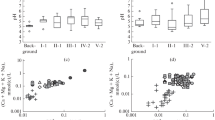Abstract
The distribution of the total Ni, Cu, Co, Cd, Pb, and Zn contents was studied in the soil profiles of six catenas in the zone subjected to emissions of the copper-nickel industrial complex, which is the largest source of SO2 and heavy metals in northern Europe. The results show that, at present, the concentrations of Ni and Cu in the upper organic soil horizons in the impact zone reach extreme levels of 9000 and 6000 mg/kg, respectively. Under conditions of the long-term intense multi-element industrial emissions, the modern levels of the accumulation of polluting substances in soils greatly depend on the indirect factors, such as the degree of the technogenic degradation of soils with the loss of a significant part of soil organic matter, the reaching of threshold saturation of the topsoil with polluting metals, and competitive relationships between chemical elements. The state of the ecosystems in the impact zone varied greatly and did not always agree with the contents of the main metals-pollutants in the soils. The moisture conditions determined by the landscape position affected significantly the resistance of the ecosystems to emissions.
Similar content being viewed by others
References
G. A. Evdokimova, G. V. Kalabin, and N. P. Mozgova, “Contents and toxicity of heavy metals in soils of the zone affected by aerial emissions from the Severonikel Enterprise,” Eurasian Soil Sci. 44, 237–244 (2011).
G. M. Kashulina, Aerotechnogenic Soil Transformation of the European Subarctic Region (Kola Scientific Center, Russian Academy of Sciences, Apatity, 2002) [in Russian].
G. M. Kashulina, A. N. Kubrak, and N. M. Korobeinikova, “Soil acidity status in the vicinity of the Severonikel copper-nickel industrial complex, Kola Peninsula,” Eurasian Soil Sci. 48, 432–444 (2015).
G. M. Kashulina, V. N. Pereverzev, and T. I. Litvinova, “Transformation of the soil organic matter under the extreme pollution by emissions of the Severonikel smelter,” Eurasian Soil Sci. 43, 1174–1183 (2010).
Classification and Diagnostic System of Russian Soils (Oikumena, Smolensk, 2004) [in Russian].
G. N. Koptsik, S. V. Koptsik, I. E. Smirnova, A. D. Kudryavtseva, and K. A. Turbabina, “The response of forest ecosystems to reduction in industrial atmospheric emission in the Kola Subarctic,” Zh. Obshch. Biol. 77 (2), 147–165 (2016).
Forest Ecosystems and Air Pollution, Ed. by V. A. Alekseev (Nauka, Leningrad, 1990) [in Russian].
N. V. Lukina and T. V. Chernen’kova, “Pollutioninduced successions in forests of the Kola Peninsula,” Russ. J. Ecol. 39, 310–317 (2008).
V. V. Nikonov, N. V. Lukina, and M. V. Frontas’eva, “Trace elements in Al–Fe-humus podzolic soils subjected to aerial pollution from the copper-nickel production industry in conditions of varying lithogenic background,” Eurasian Soil Sci. 32, 338–349 (1999).
V. N. Pereverzev, Forest Soils of the Kola Peninsula (Nauka, Moscow, 2004) [in Russian].
D. L. Pinskii, Ion-Exchange Processes in Soils (Pushchino Scientific Center, Russian Academy of Sciences, Pushchino, 1997) [in Russian].
O. G. Chertov, I. V. Lyanguzova, and E. V. Kordyukova, “Mobility of heavy metals in polluted humic-illuvial podzolic soils,” Pochvovedenie, No. 5, 50–56 (1985).
AMAP Assessment Report 2006: Acidifying Pollutants, Arctic Haze, and Acidification in the Arctic (Arctic Monitoring and Assessment Program, Oslo, 2006).
Arctic Pollution Issues: A State of the Arctic Environment Report (Arctic Monitoring and Assessment Program, Oslo, 1997).
D. Gregurek, C. Reimann, and E. F. Stumpfl, “Mineralogical fingerprint of industrial emissions—an example from Ni mining and smelting on the Kola Peninsula, NW Russia,” Sci. Total Environ. 221, 189–200 (1998).
G. Kashulina, P. de Caritat, and C. Reimann, “Snow and rain chemistry around the Severonikel industrial complex, NW Russia: current status and retrospective analysis,” Atmos. Environ. 89, 672–682 (2014).
G. Kashulina, C. Reimann, and D. Banks, “Sulphur in the Arctic environment (3). Environmental impact,” Environ. Pollut. 124 (1), 151–171 (2003).
G. Kashulina, C. Reimann, T. E. Finne, J. H. Halleraker, M. Äyräs, and V. A. Chekushin, “The state of the ecosystems in the Central Barents region: scale, factors and mechanism of disturbance,” Sci. Total Environ. 206, 203–225 (1997).
C. Reimann, M. Äyräs, V. Chekushin, et al., Environmental Geochemical Atlas of the Central Barents Region, NGU-GTK-CKE Special publication, Geological Survey of Norway, Trondheim, 745 (1998).
C. Reimann, G. Kashulina, P. de Caritat, and H. Niskavaara, “Multi-element, multi-medium regional geochemistry in the European Arctic: element concentration, variation and correlation,” Appl. Geochem. 16, 759–780 (2001).
R. Salminen, V. Chekushin, M. Tenhola, et al., “Geochemical atlas of eastern Barents region,” J. Geochem. Explor. 83, 1–3 (2004).
Kola Peninsula Pollutants and Forest Ecosystems in Lapland: Final Report of The Lapland Forest Damage Project, Ed. by E. Tikkanen and I. Niemela (Finnish Forest Research Inst., Rovaniemi, 1995).
G. Tyler, “Leaching rates of heavy metal ions in forest soil,” Water, Air Soil Pollut. 9, 137–148 (1978).
Author information
Authors and Affiliations
Corresponding author
Additional information
Original Russian Text © G.M. Kashulina, 2017, published in Pochvovedenie, 2017, No. 7, pp. 860–873.
Rights and permissions
About this article
Cite this article
Kashulina, G.M. Extreme pollution of soils by emissions of the copper–nickel industrial complex in the Kola Peninsula. Eurasian Soil Sc. 50, 837–849 (2017). https://doi.org/10.1134/S1064229317070031
Received:
Published:
Issue Date:
DOI: https://doi.org/10.1134/S1064229317070031



